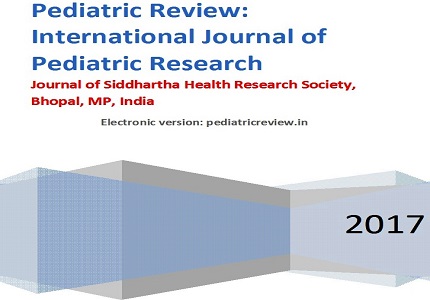A recent advance in first hour feeding – breast crawl
Abstract
Introduction: Ideally the baby should receive breast feed as soon as possible and preferably with in one hour of birth. Breast milk is right of every new born. Initiation of breast feeding in early hours, very minute after birth is crucial.
Material and methods: A prospective cohort observation study done on 200 research cases & similarly control cases were selected from full term newborn babies delivered vaginally, in one of the tertiary care teaching hospital of central India.
Results: Out of 200 full term babies, 166 babies able to successfully crawl within in 50 min. temperature maintenance were found in 98% of BC babies and 64% of non BC babies. Blood sugar normal in 100 % of BC babies and 35% of non BC babies. 100% of breast crawl babies were healthy and 95% of BC babies achieved good weight gain after 15 days follow up.
Conclusions: Breast crawl helps in faster effective achievement of feeding skill by the baby, getting colostrums, which has many antibodies and antiinfective properties, prevent hypothermia as well as hypoglycemia and boosting neurodevelopment of babies nervous system.
Downloads
References
2. Breastfeeding: achieving the new normal. Breastfeeding series: The Lancet: January 30, 2016 .http://www.thelancet.com
3. Hansen, K. The power of nutrition and the power of breastfeeding. Breastfeeding Med. 2015; 10: 385–388.available on www.ncbi.nlm.nih.gov
4. Zanardo V1, Volpe F A temperature gradient may support mother-infant thermal identification and communication in the breast crawl from birth to breastfeeding. ActaPaediatr. 2017 Jul 19. doi: 10.1111/apa.13976.
5. Moore ER, Bergman N, Anderson GC, Medley N. Early skin-to-skin contact for mothers and their healthy newborn infants. Cochrane Database Syst Rev. 2016 Nov 25;11:CD003519.
6. Aghdas K1, Talat K Effect of immediate and continuous mother-infant skin-to-skin contact on breastfeeding self-efficacy of primiparous women: a randomised control trial. Women Birth. 2014 Mar;27(1):37-40.
7. Ruth M Cantrill, Debra K Creedy. Effective suckling in relation to naked maternal-infant body contact in the first hour of life: an observation study. BMC Pregnancy Childbirth. 2014; 14: 20.clok.uclan.ac.uk
8. Kristin E Svensson, Marianne I Velandia.Effects of mother-infant skin-to-skin contact on severe latch-on problems in older infants: a randomized trialInt Breastfeed J. 2013; 8: 1.
9. Conde-AgudeloA1, Díaz-Rossello JL.Kangaroo mother care to reduce morbidity and mortality in low birthweight infants. Cochrane Database Syst Rev. 2016 Aug 23;(8).
10. Matthiesen AS, Ransjö-Arvidson AB. Postpartum maternal oxytocin release by newborns: effects of infant hand massage and sucking. Birth. 2001 Mar;28(1):13-9.
11. Nemsadze K, Silagava M. Neuroendocrine foundation of maternal-child attachment. Georgian Med News. 2010 Dec;(189):21-6. [PubMed]
12. Csont GL, Groth S, Hopkins P, Guillet R. An evidence-based approach to breastfeeding neonates at risk for hypoglycemia. J ObstetGynecol Neonatal Nurs. 2014 Jan-Feb;43(1):71-81. doi: 10.1111/1552-6909.12272. [PubMed]
13. Bragg JJ, Green R Does early enteral feeding prevent hypoglycemia in small for gestational age neonates? J Neonatal Perinatal Med. 2013;6(2):131-5.
14. Sharma D, Sharma P. Golden 60 minutes of newborn's life: Part 2: Term neonate. J MaternFetal Neonatal Med. 2016 Nov 29:1-6. [PubMed]
15. Srivastava S, Gupta A, Bhatnagar A, Dutta S. Effect of very early skin to skin contact on success at breastfeeding and preventing early hypothermia in neonates. Indian J Public Health. 2014 Jan-Mar;58(1):22-6. doi: 10.4103/0019-557X.128160.
16. Mahmood I, Jamal M, Khan N. Effect of mother-infant early skin-to-skin contact on breastfeeding status: a randomized controlled trial. J Coll Physicians Surg Pak. 2011 Oct;21(10):601-5. doi: 10.2011/JCPSP.601605.
17. Balogun OO, O'Sullivan EJ, McFadden A, Ota E, Gavine A, Garner CD, Renfrew MJ, MacGillivray S. Interventions for promoting the initiation of breastfeeding. Cochrane Database Syst Rev. 2016 Nov 9;11:CD001688. [PubMed]
18. Feferbaum R.Interventions for promoting the initiation of breastfeeding. Sao Paulo Med J. 2014;132(1):68. [PubMed]
19. Ginovart G, GichI A Fortified Donor Milk Policy is Associated With Improved In-Hospital Head Growth and Weight Gain in Very Low-Birth-Weight Infants. Adv Neonatal Care. 2017 Aug;17(4):250-257. [PubMed]
20. Klaus MH, Kennell JH, Plumb N, ZuehlkeS.Pediatrics. Human maternal behavior at the first contact with her young.2001.breastcrawl.org. [PubMed]

Copyright (c) 2017 Author (s). Published by Siddharth Health Research and Social Welfare Society

This work is licensed under a Creative Commons Attribution 4.0 International License.


 OAI - Open Archives Initiative
OAI - Open Archives Initiative


